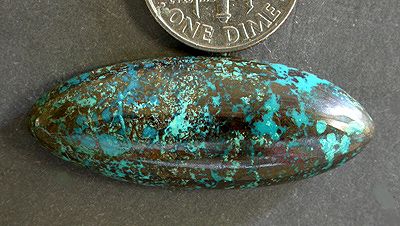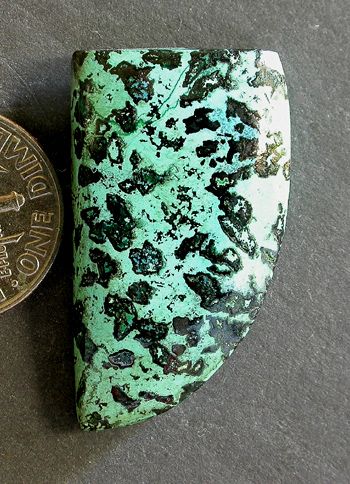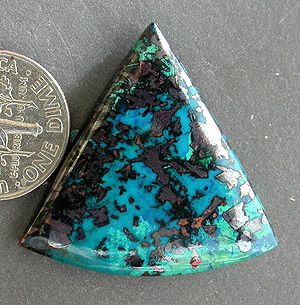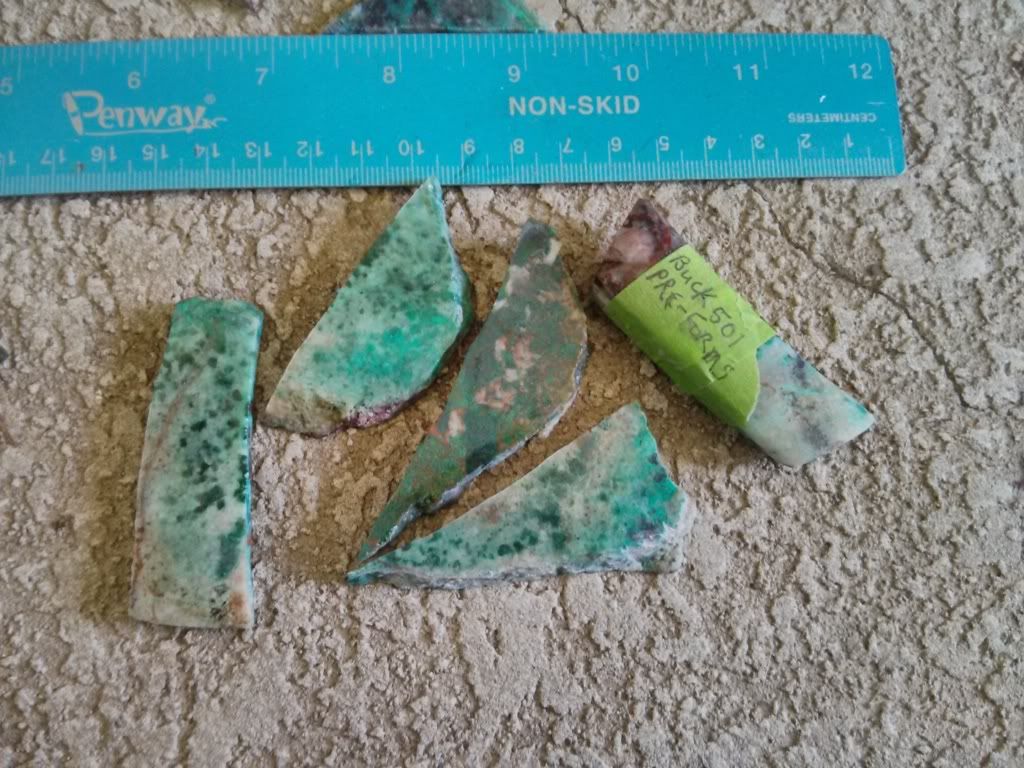gemfeller
Cave Dweller 
Member since June 2011
Posts: 4,049 
|
Post by gemfeller on Jul 3, 2013 15:39:46 GMT -5
Anybody know if these materials have a commonly used name? I picked these cabs up in a trade and I'm currently recutting them (they're too thick and blocky as-is) but I'd like to track down their trade or technical names if possible. This first batch of 3 resembles what I'm seeing sold lately as Parrot Wing. Any comments?    This second batch is like nothing I've ever seen before. It appears to be either turquoise or chrysocolla in a mass of unknown black brecciated material. The black stuff is much harder than the blue and the stones tend to undercut like mad.   There's a lot of collective knowledge and experience around here. Any comments are welcome! Rick |
|
Deleted
Deleted Member
Member since January 1970
Posts: 0
|
Post by Deleted on Jul 3, 2013 16:43:28 GMT -5
The last pieces look like some of the Nevada variscites, which look similar.
|
|
|
|
Post by deb193redux on Jul 3, 2013 16:54:26 GMT -5
I was thinking varasite to, but the pattern isunusual
|
|
gemfeller
Cave Dweller 
Member since June 2011
Posts: 4,049 
|
Post by gemfeller on Jul 3, 2013 17:58:20 GMT -5
Thanks to both of you but it's definitely not variscite. I've cut a lot of both the Utah and Nevada variscites and know them well. The actual stones are much bluer than these images but I can't seem to capture the true color -- at least in these quick shots.
|
|
Deleted
Deleted Member
Member since January 1970
Posts: 0
|
Post by Deleted on Jul 3, 2013 18:06:57 GMT -5
|
|
gemfeller
Cave Dweller 
Member since June 2011
Posts: 4,049 
|
Post by gemfeller on Jul 3, 2013 19:08:01 GMT -5
Shotgunner, those are both drop-dead gorgeous! Congratulations to Krystee and beefjello. Still I'm confused. Krystee's stone seems more like classic Parrot Wing jasper (Google for parrot wing jasper images) even though the name of the material in her post seems very firm; while beefjello's stone fits my notion of Shattuckite. Still, there seems to be quite a bit of cross-over between the Parrot Wing and Shattuckite (Google Shattuckite images.) The names and trade names for some copper mineral gems has always seemed very tangled to me. For instance this material was marketed long ago as Stellarite:  And I have no idea what to call this lovely material. I bought a single unnamed slab at a gem show and cut this cab from it. It shows metallic copper, some white metal, turquoise, chrysocolla, malachite and other unidentified minerals. Very confusing!  Rick |
|
|
|
Post by orrum on Jul 3, 2013 21:30:16 GMT -5
Dont know for sure but the top one has almost a brown matrix and turqioise pattern like Number 8 mine turquoise. The second one could be a foreign turqioise or american variquoise. Whats the mine that is the only one to have turquoise in a volcano field? Its supposed to have a extremely hard black matrix, cant remember the name. I would be careful recutting them, if they r cut thick it might b because they r not backed. I would back them with Devcon to be safe. Just my newbie two cents worth.
|
|
|
|
Post by helens on Jul 3, 2013 21:31:33 GMT -5
We have a big long thread about naming conventions for the copper minerals on the lapidary gems forum... That might be shattuckite, but it's not quite the same. Here is Shattuckite, old stock, from Michael Hoover, who's been using the materials for decades:  I bought some of his unusable for his blades pieces for cabbing. Now I haven't cabbed them yet, these are the raw pieces. Here's another group (he generously threw in a pair of buck knife preforms, but I don't have a buck knife to make yet):  Since mine aren't polished, here's a pix of one of Michael Hoover's finished pieces made from Shattuckite: redrummdknives.blademakers.com/Knife_Image_PopUp.asp?Ref_Num=3947Here's another, using the same rocks as the preform set he sent me: redrummdknives.blademakers.com/Knife_Image_PopUp.asp?Ref_Num=4019And a 3rd: redrummdknives.blademakers.com/Knife_Image_PopUp.asp?Ref_Num=4009Those are all shattuckite. I'm not seeing the shiny copper effects on any of the shattuckite... although the colors are very similar. On the thread we talked about it, we basically came to the conclusion that there's so many potential mixes that it's most accurate to call them by their constituent components... which are: Chrysocolla-(Cu,Al)2H2Si2O5(OH)4·nH2O - hardness 2.5 to 3.5 Shattuckite Cu5(SiO3)4(OH)2 - Hardness 3.5 Azurite - Cu3(CO3)2(OH)2 - Hardness 3.5 - 4 Malachite Cu2CO3(OH)2 - hardness 3.5–4.0 Varisite AlPO4·2H2O - hardness 4.5 Turquoise - CuAl6(PO4)4(OH)8·4H2O -hardness 5–7 Gem Silica = Chrysocolla (can't find the direct formula, probably because it's such a complex composite, but MOSTLY quartz to get the hardness?) - hardness 7 Obviously, all of them are copper based, some are carbonates, others are phosphates. Most occur together (except the turquoise). Those are JUST the blues and greens, there's a LOT of other minerals they can combine with, but I got lazy and only listed the blues and greens:P. When I asked Michael about the components in Shattuckite, his reply: "I refer to it as Shattuckite as that was the main copper mineral in the vein. Along with the Shattuckite are Cuprite, Chrysocolla, Anjoite, Chalcocite and Malachite. I sell some of the knives as Chrysocolla in Quartz, some as Malachite and Chalcocite in Quarz and I generally try to remember to note that the other minerals that are mixed in with the main colors and try to explain the pseudo-morphing to quartz. The rarest mix in what I sent is the green with pewter colored small pieces which are Malachite and Chalcocite in Quartz. Now take that mix of copper minerals and add pseudo-morphing over to being more and more quartz (silica) and the atom by atom mixing of the copper minerals with the developing quartz from the silica. You now have what I sent to you with all of the mix of minerals and varying hardness depending on how much of the original copper mineral has been pseudo-morphed." Hope that helps:). |
|
|
|
Post by helens on Jul 3, 2013 21:34:46 GMT -5
Quick note... I only showed a pix of some of the pieces he sent, I have more. These were the ones that are closest to what you have.
But note his quote above: "The rarest mix in what I sent is the green with pewter colored small pieces which are Malachite and Chalcocite in Quartz."
Maybe that's what you have in the green? "Rarest" to him is RARE indeed, you should see his rocks. Which would make sense given how few people have seen rocks like you posted.
|
|
gemfeller
Cave Dweller 
Member since June 2011
Posts: 4,049 
|
Post by gemfeller on Jul 3, 2013 22:16:43 GMT -5
Dont know for sure but the top one has almost a brown matrix and turqioise pattern like Number 8 mine turquoise. The second one could be a foreign turqioise or american variquoise. Whats the mine that is the only one to have turquoise in a volcano field? Its supposed to have a extremely hard black matrix, cant remember the name. I would be careful recutting them, if they r cut thick it might b because they r not backed. I would back them with Devcon to be safe. Just my newbie two cents worth. Hi Orrum, thanks for your thoughts. You can definitely rule out Number 8 turquoise but it's a great guess based on appearance. I'm very familiar with Number 8. I'd be interested in learning the name of the volcanic turquoise mine you mention if you remember it. I'm more inclined to think it's a foreign turquoise since my stones came from Asia although they could be from anywhere. As for the recuts, I've worked with lots of copper minerals and turquoise. These stones definitely don't need backing. I think the red/brown material is a form of cuprite, not the bright red variety in Sonora Sunrise/Sunset but more like an ore mineral. It's strong and bloody heavy! The density/specific gravity of the groundmass is what got me going on this topic. I just bought a parcel of rough described as Parrot Wing but it closely resembles the first 3 stones I posted. Since I plan to eventually sell stones cut from it I want to describe them accurately. Thanks for your thoughts. Rick |
|
gemfeller
Cave Dweller 
Member since June 2011
Posts: 4,049 
|
Post by gemfeller on Jul 3, 2013 22:31:19 GMT -5
On the thread we talked about it, we basically came to the conclusion that there's so many potential mixes that it's most accurate to call them by their constituent components... When I asked Michael about the components in Shattuckite, his reply: "I refer to it as Shattuckite as that was the main copper mineral in the vein. Along with the Shattuckite are Cuprite, Chrysocolla, Anjoite, Chalcocite and Malachite. Hope that helps:). Hi Helen, Thanks for taking the time. I've edited your response to the essentials that I've distilled in my own mind: "It's a dang pretty bunch of copper minerals!" Unfortunately not everyone is equipped to identify each one by name. I fell in love with copper-derived gems when I was quite young. I still believe, many years later, they're among the most lovely of all gem materials. I've always lusted for a top quality pure gem silica cab to be set into a man's ring for me. No cigar. Guess I'll have to be satisfied with a nice fire agate. Rick |
|
|
|
Post by helens on Jul 3, 2013 22:46:24 GMT -5
Several members on this forum belong to another forum where there are more gemmy type materials. While this isn't gem silica (chrysocolla in quartz) it's chrysocolla in OPAL and I can't see a big difference... think this may be prettier:  Would this be a good substitute? |
|
|
|
Post by helens on Jul 3, 2013 22:54:34 GMT -5
Dont know for sure but the top one has almost a brown matrix and turqioise pattern like Number 8 mine turquoise. The second one could be a foreign turqioise or american variquoise. Whats the mine that is the only one to have turquoise in a volcano field? Its supposed to have a extremely hard black matrix, cant remember the name. I would be careful recutting them, if they r cut thick it might b because they r not backed. I would back them with Devcon to be safe. Just my newbie two cents worth. Hi Orrum, thanks for your thoughts. You can definitely rule out Number 8 turquoise but it's a great guess based on appearance. I'm very familiar with Number 8. I'd be interested in learning the name of the volcanic turquoise mine you mention if you remember it. I'm more inclined to think it's a foreign turquoise since my stones came from Asia although they could be from anywhere. As for the recuts, I've worked with lots of copper minerals and turquoise. These stones definitely don't need backing. I think the red/brown material is a form of cuprite, not the bright red variety in Sonora Sunrise/Sunset but more like an ore mineral. It's strong and bloody heavy! The density/specific gravity of the groundmass is what got me going on this topic. I just bought a parcel of rough described as Parrot Wing but it closely resembles the first 3 stones I posted. Since I plan to eventually sell stones cut from it I want to describe them accurately. Thanks for your thoughts. Rick If it's really heavy... could it possibly be hematite? Hematites are HEAVY (iron). Maybe if your rocks contain both iron and copper... that would help you narrow down the search for locale...? |
|
gemfeller
Cave Dweller 
Member since June 2011
Posts: 4,049 
|
Post by gemfeller on Jul 4, 2013 0:49:39 GMT -5
Would this be a good substitute? Opal of any kind isn't really recommended for a man's ring -- too soft and fragile. Is this the prase opal from Tanzania? If so it's colored by nickel (like chrysoprase) not copper. I have several pounds of another rare green opal colored by nickel from Macedonia. Actually, I'll find the gem silica I want one of these days. There's still some fine material from places like the Ray Mine in AZ on the market but it takes some searching to find just the right stone. Thanks for your suggestion. Rick |
|
|
|
Post by helens on Jul 4, 2013 1:59:07 GMT -5
No, it's one of the rarest, and newest, stones out of Indonesia. I haven't gotten any of it, it's fairly pricey (but not as pricey as gem silica!). But you are right... the opal has to be too soft for a man's ring, wasn't thinking of that. The color is nearly identical to the gem silica tho.
For a man's ring, how can you POSSIBLY go wrong with the fire agate in your avatar pix? That has to be one of the closest cuts to the bubble I've ever seen... and no gem silica can compare to that color, let alone the insane skill required to accomplish getting that cut to a micro millimeter of the bubbles (even tho you did break through the red, but talk about the luck to find that green right under it... that's incredible... unless the green was the top...O.O).
|
|
gemfeller
Cave Dweller 
Member since June 2011
Posts: 4,049 
|
Post by gemfeller on Jul 4, 2013 12:00:43 GMT -5
For a man's ring, how can you POSSIBLY go wrong with the fire agate in your avatar pix? You can't. But I'm greedy and I want a fine gem silica ring too  My avatar image is just a tiny section of a fire agate magnified many times. I can't even recall which stone it came from. But I've made several fire agate rings and I'm planning another ASAP. Rick |
|
|
|
Post by stoner on Jul 4, 2013 20:17:33 GMT -5
I think the first set of rocks is what they call Apache Chrysocolla, a combination of Chrysocolla, Cuperite, and tenorite and a few other things sometimes. It comes from Mexico and New Mexico. It's usually more stabile than Chrysocolla.
|
|
gemfeller
Cave Dweller 
Member since June 2011
Posts: 4,049 
|
Post by gemfeller on Jul 4, 2013 20:29:50 GMT -5
Thanks for the suggestion Stoner. I'll do some research on that name and material. The new rough I received that looks very similar to the cabs definitely comes from Mexico. You're so right about pure chrysocolla instability! Both my cabs and the new rough are very stable. But the stuff is heavy! When I get a minute I'll try to check the Specific Gravity to see if it matches cuprite. It won't be accurate because of the other minerals but maybe close enough for an ID.
|
|